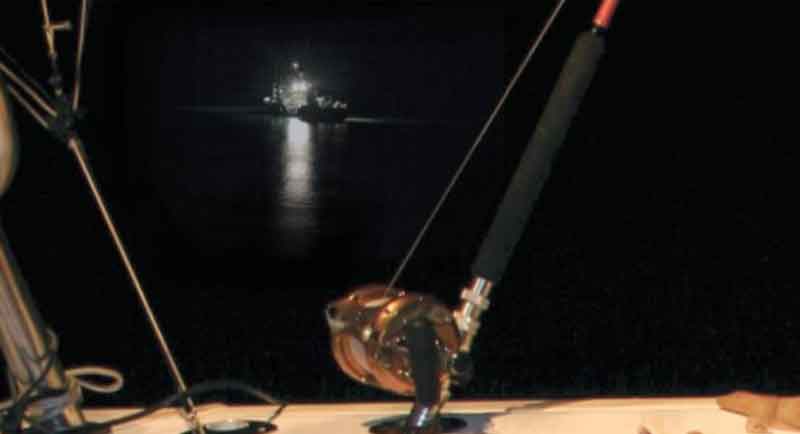Gravity has gone amuck, and I’m rudely awakened from a short nap on the V-berth by my head slamming into the Porta-Pottie. Ouch. And, ick. Then gravity reverses course, tossing me back onto the berth and then into a bulkhead. Ouch, again. What the hell is going on? Why are the engines running, and why is someone at the helm gunning the throttles when we’re supposed to be drifting for swordfish? Before I can voice these questions, the boat slows. “It’s okay,” I hear from on-deck. “I think we’re clear of it now.” I pop through the entry, and look around: my mate, who had been on watch, is standing at the wheel with a scared look on his face. The two guys we’ve taken on this all-night fishing excursion are picking themselves up off the deck and checking themselves for injury. And there’s a bank of white lights off the stern. I look at my mate. “How could you miss that?” I ask. “That ship should have been visible from five miles away.” He looks down sheepishly, and admits the obvious: “I think I fell asleep…”

After I spit out a stream of invectives, we set about cleaning up the mess of tangled lines and spilled butterfish chunks. At some point, I realized that the “ship” was actually another fishing boat, and it wasn’t moving. The bright halogens were their fishing lights, and the boat had merely pulled up to drift the same edge of Washington Canyon that we were working. So, why had our nautical narcoleptic thought the boat was bearing down on us, when he woke up and saw the lights? Because being on the water can deceive your senses. If you captain your own boat, always be on the lookout for:
- The Autokinetic Effect – Also called “induced movement,” this is what made him think a drifting boat was cruising. It’s a glitch in visual perception that occurs when the six extraocular muscles which control eye movement are strained, and send erroneous messages to the brain. Essentially, tension in the tiny muscles cause your brain to think that a stationary light or object in the darkness is moving, or makes a distant item seem to dance on the horizon. The amplitude of precepted movement varies from brain to brain, so one person may think an object is moving quickly while another may look at the very same object at the very same time, and think it’s moving slowly. But there’s a solution: When you think the autokinetic effect may be influencing your visual acuity, move your focal point off of the object and observe it through your peripheral vision. That allows your eye muscles to remain more relaxed, and you can accurately ascertain whether the movement is real or not. (There's a pretty good explanation of the autokinetik effect at Wikipedia, if you want to learn more about it).
- Pernicious Perception – If you’ve ever set foot on a boat, I don’t have to tell you how difficult it can be to judge distances. Without the aid of electronics one person might judge a boat to be a mile away, while someone standing right next to them would swear it’s three miles away. Fight the phenomenon with math. Distance to the horizon equals 1.17 times the square root of the height of your eye. If your eye is nine feet above sea level when you stand at the helm, the equation is three times 1.17, or 3.51. So the horizon is three and a half miles away, and a boat that appears to be half way to the horizon is around 1.75 miles off (assuming clear atmospheric conditions).
- Auditory Abnormalities – Have you ever noticed that the constant drone of a boat’s engine and wind-noise can mask some sounds, or create some other mirage-like ghost sounds that don’t actually exist? As a person’s ears strain to pick out specific sounds from what is essentially static, auditory hallucinations become common. So the next time you’re halfway through a long cruise and you hear a little boy’s voice croaking “red rum… red rum…” don’t freak out. You haven’t gone schizo, your ears are just on overload.
Now let’s put some thick fog into the mix, turn out the lights, add a healthy dose of pitching waves, and dash of visual and auditory confusion. Is it any wonder your frontal lobe might interpret that spider buoy as a man walking a dog that sounds like a goat? At least now, you’ll know how to deal with it… assuming you can stay awake.